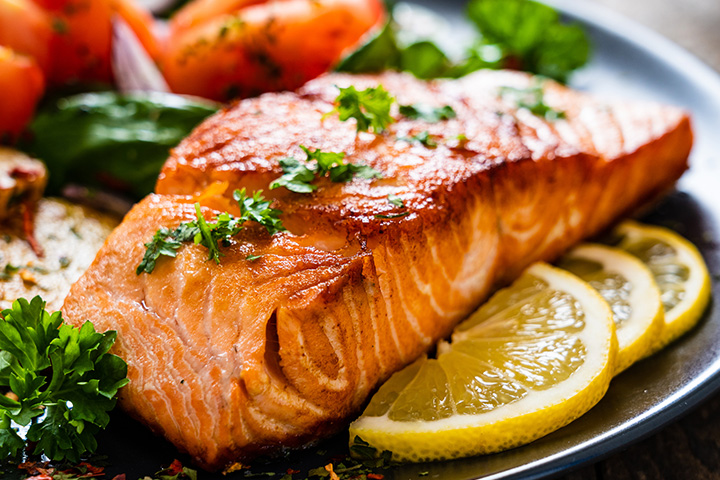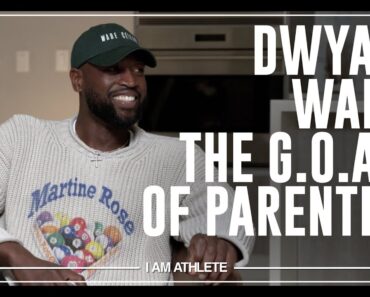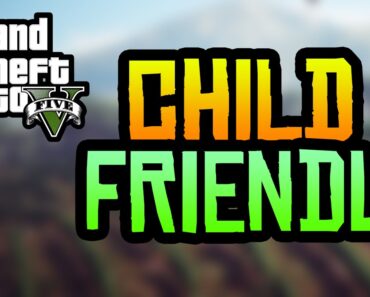Image: iStock
Salmon is a low-mercury, fatty fish that has a soft, flaky texture. It is rich in lean protein, omega-3 fatty acids (EPA and DHA), vitamins, and minerals (1). These attributes make salmon an excellent choice to add to your baby’s weaning foods. But before you begin feeding salmon to babies, check if salmon is safe for babies? What are the right age and age-appropriate ways to feed salmon to babies?
This post answers your queries and tells you about the health benefits of salmon, potential risks, and some salmon recipes to try for babies.
Is Salmon Safe For Babies?
Yes, “salmon is safe for babies. As it is low in mercury, it is safe for babies to eat salmon two to three times a week,” says California-based pediatrician and health advocate Dr. Pierrette Mimi Poinsett.
Eating salmon can offer nutrients such as vitamin D and calcium, which are necessary for healthy bone development (2). Besides, it is rich in omega-3 fatty acids that aids in the central nervous system (brain and nerves) and eye development (3). It is why experts consider salmon a vital seafood option for babies and toddlers (4).
Note: Although fish is a common allergen, “there’s no need to delay its introduction in babies,” says the American Academy of Pediatrics (AAP) (5). However, if your baby has any other food allergies or has a family history of fish allergy, consult your doctor before feeding any fish, including salmon, to your baby.
When Can Babies Eat Salmon?
According to Dr. Florencia Segura, Pediatrician and Fellow of the American Academy of Pediatrics (FAAP), “Salmon is an excellent baby food because it is easy for babies to finger feed due to its soft and flaky nature.”
It means a baby’s diet can include fish within a few months of starting solids (6). Thus, babies older than six months, who are eating various solid foods, can eat steamed, baked, or boiled salmon in puree and mash forms. Alternatively, you can serve salmon in small pieces for baby-led weaning. As the baby grows, they can consume different roasted, poached, pan-seared, and grilled salmon dishes across meals.
According to the Centers for Disease Control and Prevention (CDC), you should remove all the fat, skin, and bones from the fish before preparing it for babies (7). Removing fatty skin ensures you reduce the baby’s exposure to toxins, such as PCBs (8). On the other hand, separating bones minimizes the choking risk.
Nutritional Value Of Salmon
There are six types (Atlantic, Chinook, Chum, Coho, Pink, and Sockeye) of salmon available in the US in fresh, canned, and frozen forms (1). The nutritional composition of these types varies from one another.
Here’s the approximate nutritional composition of three ounces of raw pink salmon against the recommended dietary allowance of vital nutrients (9) (10) (11).
Nutrients | Amount | RDA (7-12 months) |
Energy | 108Kcal | – |
Total lipid (fat) | 3.74g | – |
Protein | 17.4g | 11g |
Calcium, Ca | 5.95mg | 260mg (AI) |
Magnesium | 23mg | 75(AI) |
Potassium | 311mg | 860(AI) |
Sodium, Na | 63mg | 370mg (AI) |
Iron, Fe | 0.32mg | 11mg |
Selenium | 26.7µg | 20µg |
Vitamin A | 35µg RAE | 500µg RAE(AI) |
Vitamin D (D2+D3) | 370IU | 400IU |
Source: Food Data Central and Dietary Guidelines for Americans 2020-2025
AI = Adequate intake – nutrient level assumed to ensure nutritional adequacy
IU = International Units
Note: You may hear or read information urging you to choose wild salmon over farmed ones as they are low in contaminants. However, the Washington State Department of Health notes that “both wild and farmed salmon have low levels of mercury, PCBs, and other contaminants (12).”
Possible Health Benefits Of Salmon For Babies And Toddlers
Salmon is a nutrient-rich fish that can contribute to your baby and toddler’s daily nutritional needs and impart the following benefits:
1. Supports growth and development: Fish offers nutrients, such as high-quality lean protein, vitamin D, and calcium. The body uses these nutrients for several functions, such as cartilage and skin development, tissue repair, and bone and muscle growth (13). Similarly, fish provides omega-3 fatty acids (EPA and DHA), which support the central nervous system, eye, and immune system development (11).
2. Facilitates physiological functions: Fish offers several B vitamins, such as B3, B6, B9, and B12 (13). Babies and toddlers need these vitamins to perform different physiological functions, such as energy metabolism, red cell production, and hormonal balance. Likewise, selenium in fish ensures proper thyroid function.
3. Helps combat inflammation: Nutrients, such as omega-3 fatty acids, vitamin E, and selenium found in fish, helps combat inflammation (14). Likewise, astaxanthin is an antioxidant in salmon that fights free radical damage, reduces inflammation, and boosts immunity (13). It is the same pigment that gives salmon its pink color.
Besides these, fish consumption is associated with several long-term health perks, such as improved brain health and reduced risk of neurodegenerative diseases (15).
How To Select And Store Salmon?
Proper selection and appropriate storage of salmon are essential to ensure its quality and safe intake. Here are some tips that you should keep in mind.
Selection
Depending on the source, salmon has two broad categories — Alaskan Salmon and Pacific salmon. Then, there are the sub-categories wild-caught and farm-raised. These categories tell how the salmon was raised. You can purchase either type of salmon using the following tips.
For fresh salmon:
- First, smell the salmon. A fresh salmon doesn’t smell like fish. Ideally, it will have no smell at all.
- Check their skin. It should be clean, shiny, and slippery to touch, and its gills should have deep red to pink color with marbling.
- Avoid salmon with any brown spots or bruises around the edges or its belly. If its edges are curling up, the fish is most likely not fresh.
- Take a careful look at their eyes. A fresh catch will have clear and bright eyes and not sunken or cloudy. Also, they will be firm to touch.
- If buying a fillet, poke its flesh. A fresh salmon flesh bounces back upon poking. Also, it doesn’t leave the fingerprint on the fish.
For frozen and canned salmon: - Buy low-sodium canned salmon and check its best before date before purchasing.
- While buying frozen salmon, check the fish’s surface and look for ice crystals. Also, see if there are any dried, cottony patches indicating freezer burn. Finally, ensure that the vacuum packaging is intact and has no loose ends.
Salmon has several varieties, so know them well to purchase the best fish. For instance, the Chinook salmon is the oiliest and largest salmon with the pinkest flesh. On the other hand, chum salmon and pink salmon are the smallest salmons with the palest hue and lowest oil content.
Storage
Storing salmon the correct way is essential to preserve its nutritional composition and quality. Here are some helpful tips.
- As soon as you get the fresh salmon home, refrigerate it immediately between 0˚ C to 4˚ C.
- Use the fresh salmon within one to two days. If the fish is packaged, refer to the packaging for the best before date.
- Store unused fresh salmon in a vacuum or airtight freezer bag in the freezer for up to three months.
- Store canned salmon unopened at room temperature for up to three years. Check the best before date while purchasing the can.
- Once the can is open, remove the salmon from the can, store it in an airtight freezer container or bag, and use it within three to four days.
Tips To Cook And Feed Salmon To Babies
Fish, such as salmon, is a common allergen. Hence, it is vital to ensure that you take necessary precautions while cooking and feeding salmon to babies.
- Follow the tips to buy and store salmon safely. You can feed fresh, frozen, or canned salmon to babies, provided it is well-cooked. Undercooked fish may have bacteria that can affect the baby’s health adversely.
- Remove the fat, skin, and bones from the salmon before cooking. It is crucial as the fish may have tiny bones, so “make sure that the salmon is bone-free, then steam the salmon until it is flaky. You can mash the salmon after cooking so younger infants can eat it without needing teeth. On the other hand, older infants above nine months of age can eat salmon in pieces,” says Dr. Poinsett. If you are using canned salmon, be careful as it contains several tiny bones, which should be removed first.
- Never cook salmon in the oven at a temperature below 325°F (162°C) as bacteria found in fish may not be killed at lower temperatures. So, whatever cooking method you opt for, cook salmon thoroughly. “My favorite way to cook salmon for babies is by brushing it with olive oil and herbs and baking the salmon at 350 for 15-18 minutes. The salmon naturally flakes into small pieces, which is great finger food! You can puree this salmon recipe and spread it on small pieces of soft bread for babies to feed. Making salmon cakes is another fun way to feed salmon to babies,” suggests Dr. Segura.
- Abstain from high-sodium cured, dried, salted, and smoked fish. Excess sodium can alter your baby’s taste preferences and incline them towards salty foods. Besides, it can put pressure on the baby’s immature kidneys.
- Introduce well-cooked salmon to babies in puree and mash form. Once the baby adjusts to salmon’s taste and digestibility, you can feed baked, grilled, and roasted salmon dishes to babies.
- Maintain a gap of three to five days between feeding salmon and starting any new food. It will help the baby adjust to salmon’s digestibility and rule out any sensitivity or allergy.
- Start feeding salmon to babies in small amounts, say a teaspoon or two. Stay vigilant on possible signs of allergy or intolerance. If the baby looks uncomfortable after feeding salmon, discontinue feeding immediately, and reintroduce later.
- Allergy to salmon is common but less than other foods, such as milk and soy. If an individual has a salmon allergy, they may develop mild to severe allergic reactions. Some common allergy signs are hives (red skin rashes), itchy skin, swelling around the mouth and throat, wheezing, sneezing, nausea, abdominal pain, and diarrhea (16). A severe allergic reaction is called anaphylaxis, which requires prompt medical care.
Tasty and Healthy Salmon Recipes For Babies
Here are some easy-to-prepare, tasty, and age-appropriate salmon recipes for babies and toddlers.
1. Baked salmon
You will need:
How to make:
- Preheat the oven to 356°F (180°C).
- Put the salmon into an ovenproof dish and bake it covered for about 20 minutes.
- After 20 minutes, check if the fish is cooked through and set it aside cool.
- Before serving, check if the fish has any bones and remove them.
- Flake a quarter of salmon into a bowl using a clean fork and feed your baby.
2. Pumpkin and salmon puree (6+ months)
You will need:
- ½ cup pumpkin (cooked and mashed)
- ¼ cup skinless and boneless salmon fillet (baked)
- ½ red onion (chopped)
- ¼ tsp lemon pepper seasoning
- 1tsp olive oil
How to make:
- Put all the ingredients into a blender and blend well to make a smooth puree. Ensure no lumps are present.
- Add some water if the puree looks too thick. Then, pour the puree into a bowl and feed your baby.
- You can add one-fourth teaspoon of lemon juice to enhance the dish’s flavor.
3. Salmon sweet potato fish cake (8+ months)
You will need:
- 2 salmon fillets (cooked and finely chopped)
- 1 small sweet potato (mashed)
- 1 egg
- 1tsp dried dill
- 2tbsp green onion or chives (finely chopped)
- ¼ tsp black pepper powder
- 2tbsp olive oil
How to make:
- Put all the ingredients (except olive oil) into a bowl and mix well until everything looks well combined.
- Scoop two to three tablespoons of the mixture, place it on your palm, and roll it slowly into a small cake/patty. Repeat the process and make cakes with the remaining mixture. Finally, place all the cakes/patties on a plate.
- Now, place an iron skillet over medium-high heat and spread a tablespoon of oil on it.
- As the oil warms, place three to four patties on the skillet, leaving some space between each patty.
- Cook the patties for three to four minutes on each side. Once done, place them on a plate. Repeat the process with other cakes.
- Serve one salmon sweet potato cake to your baby for self-feeding with yogurt-mint dip or avocado dip for added taste and nutrition.
4. Salmon veggie frittata (12+ months)
You will need:
- 1 medium potato (peeled and diced)
- ½ medium sweet potato (peeled and diced)
- 1 canned salmon (drained and washed)
- 4 eggs (lightly whisked)
- ½ cup baby spinach leaves (washed and chopped)
- ½ cup mixed cheese (grated)
- 1tbsp olive oil
- 1-2tbsp water
How to make:
- Preheat the oven to 392°F (200°C).
- Place the potato and sweet potato in a roasting tray, drizzle over some oil and give a gentle toss to coat all the diced veggies.
- Put the roasting tray into the oven and roast for about 20 to 30 minutes until the potato and sweet potato turn golden and tender.
- Meanwhile, preheat the grill. While the grill is heating, place a frying pan over low heat. Put the potato and sweet potato at the frying pan base in a single layer.
- Next, add a layer of spinach leaves on the top of the potato and sweet potato layer. Then, on top, place the salmon and grated cheese.
- Pour the whisked eggs over the layers and let the dish cook over low heat for eight to ten minutes until the egg begins to set around the edges yet is still runny in the center.
- Once done, place the pan under the grill and cook for an additional five minutes until the egg sets and the frittata develops a golden brown top.
- After five minutes, remove the pan from under the grill and set it aside to cool. Cut into thick fingers and serve to your baby with a dip of choice.
Salmon is a nutrient-rich, oily fish that can be beneficial for babies when fed in moderation as a part of a well-balanced diet. You can feed wild or farm-raised salmon to babies as soon as they begin eating various solid foods. Begin with salmon puree or mash, and then gradually progress to different dishes such as salmon finger and salmon cake.
References:
1. Salmon, Seafood Health Facts: Making Smart Choices; Delaware Sea Grant https://www.seafoodhealthfacts.org/seafood-choices/description-top-commercial-seafood-items/salmon
2. American Academy of Pediatrics Says US Children Are Not Eating Enough Seafood; AAP https://www.healthychildren.org/English/news/Pages/AAP-Says-US-Children-Not-Eating-Enough-Seafood.aspx
3. Essential Fatty Acids; Oregon State University https://lpi.oregonstate.edu/mic/other-nutrients/essential-fatty-acids
4. Salmon Baby Food Gives a Nutritional Boost to Infants and Toddlers; USDA https://www.usda.gov/media/blog/2010/09/15/salmon-baby-food-gives-nutritional-boost-infants-and-toddlers
5. AAP Clinical Report Highlights Early Introduction of Peanut-based Foods to Prevent Allergies; AAP https://www.healthychildren.org/English/news/Pages/Early-Introduction-of-Peanut-based-Foods-to-Prevent-Allergies.aspx
6. Starting Solid Foods; AAP https://www.healthychildren.org/English/ages-stages/baby/feeding-nutrition/Pages/Starting-Solid-Foods.aspx
7. When, What, and How to Introduce Solid Foods; CDC https://www.cdc.gov/nutrition/infantandtoddlernutrition/foods-and-drinks/when-to-introduce-solid-foods.html
8. Reduce Exposure to Contaminants in Fish; Washington State Department Of Health https://www.doh.wa.gov/CommunityandEnvironment/Food/Fish/ReduceContaminantExposure
9. Fish, salmon, pink, raw, FDC ID: 175138; Food Data Central https://fdc.nal.usda.gov/fdc-app.html#/food-details/175138/nutrients
10. Dietary Guidelines for Americans, 2020-2025; USDA https://www.dietaryguidelines.gov/sites/default/files/2020-12/Dietary_Guidelines_for_Americans_2020-2025.pdf
11. Infant Nutrition and Feeding; USDA https://wicworks.fns.usda.gov/sites/default/files/media/document/Infant_Nutrition_and_Feeding_Guide.pdf
12. Farmed Salmon vs. Wild Salmon; Washington State Department Of Health https://www.doh.wa.gov/communityandenvironment/food/fish/farmedsalmon
13. 12 Health Benefits Of Salmon For The Heart, Brain, And Much More; Safe Beat https://safebeat.org/cardiac/heart_health/12_health_benefits_of_salmon_for_the_heart_brain_and_much_more/
14. Health Benefits of Salmon: Pt. 1; IFIS https://www.ifis.org/blog/2012/food-science-and-technology/health-benefits-of-eating-salmon-part-one
15. Brain Health and Fish; Eat Right https://www.eatright.org/health/wellness/healthy-aging/brain-health-and-fish
16. Fish Allergy; ACAAI https://acaai.org/allergies/types/food-allergies/types-food-allergy/fish-allergy


































